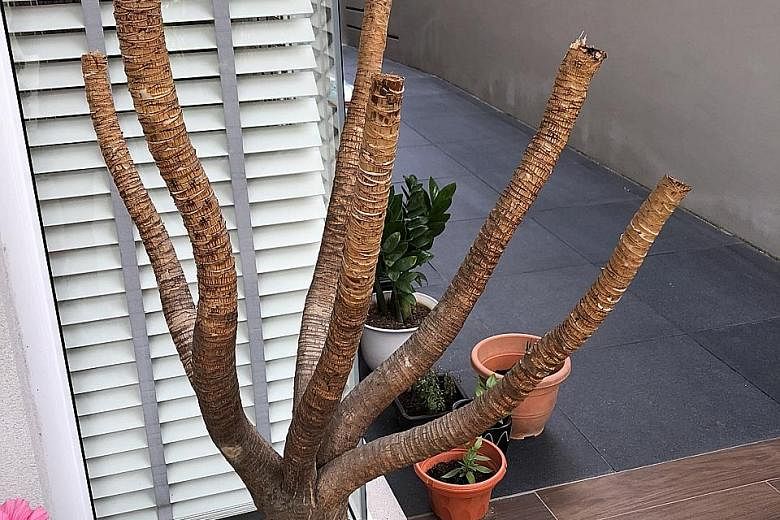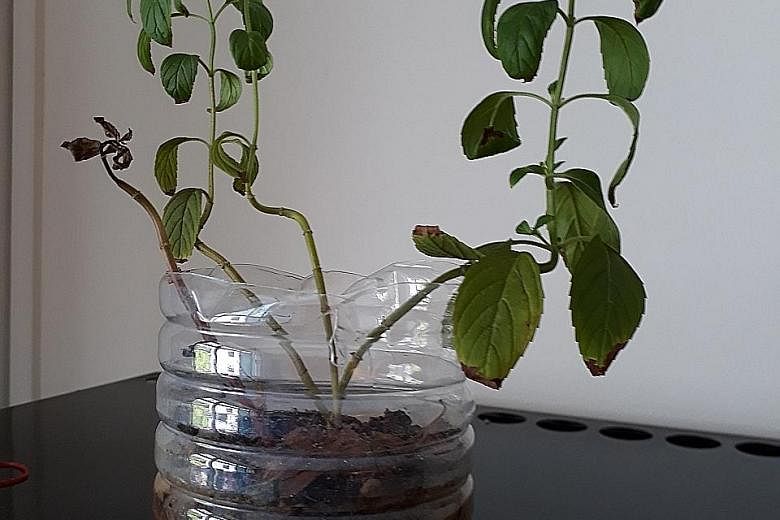Palm needs water, but less sunlight
My plant is not growing well. Its leaves are turning brown and parched though I water it once every two days. What plant is this and how can I keep it healthy?
James Tan
The plant is a palm, likely the young plant of Licuala grandis, which is commonly known as the Vanuatu Fan Palm and Ruffled Fan Palm.
From the symptoms, it appears your palm is either lacking in water or grown under overly intense sunlight.
This palm should never be allowed to dry out. The soil should be kept moist at all times.
The pot looks too small for the plant as the roots appear to have filled the container. The plant should be moved to a slightly larger pot with soil that is well-drained and moisture-retentive.
In terms of sunshine exposure, the plant should be exposed to at least four hours of filtered sunlight.
It can adapt to higher light levels, but only if the soil is kept moist at all times.
It should not be grown in a windy spot as winds can dry the plant out as well as damage its fan-shaped leaves that are produced when the plant is older.

Dracaena's regrowth depends on original condition
I have had this plant for about four years. It was growing well until about six months ago. Spots were seen on the leaves and then they started to turn brown from the tips and eventually dropped. How can I encourage the plant's leafy regrowth?
Loh Siok Hoon
The plant is likely a dracaena. Whether the plant will regrow depends on its overall health. If the plant was weak to begin with, chances of it regrowing will be low.
Without pictures showing the issue you faced earlier, it is difficult to pinpoint what was infecting your plant.
Dracaenas are best grown in well-lit locations.
Although they are often touted as shade-tolerant plants, they tend to do better if they get at least four hours of filtered sunlight daily.
Plants grown in shady spots will be prone to pests and diseases.

Lanky mint plant due to lack of sunlight
I have been trying to grow these mint plants for several weeks, but they look thin and unhealthy. The leaves are curled and turn black at the tips. I water the plants twice daily. How do I save them?
Margaret Chong
It looks like your mint plants (Mentha species) lack sunlight. The lack of sunlight will lead to a plant that is lanky in its growth. It will also increase its chances of being infected by pests and diseases.
Mints prefer to be grown in a sunny spot.
In an apartment where sunlight is available only for certain hours daily, you need to place the pot at a spot where the plant can receive at least four hours of direct or filtered sunshine.
If sunlight is lacking, the plant can be grown under grow lights. They need to be exposed to grow lights for at least 12 hours daily.
Thorn Apple is toxic
When my neighbour moved homes, I was asked to take care of this potted plant, which has longitudinal purple flowers. What is the name and species of the plant and will the flowers develop into useful fruit?
Elena Tang
The plant is a purple-flowered cultivar of Datura stramonium, commonly known as the Devil's Trumpet and Thorn Apple, with reference to the appearance of its flowers and fruit, respectively.
It is a member of the tomato family (Solanaceae) and all parts of the plant are poisonous. Keep the plant out of the reach of children and pets. It grows best in a sunny location and is easily raised from seeds.
The plant has medicinal properties, but in view of its toxic nature, it is recommended that you do not selfmedicate. Seek professional advice before using it.
Butterfly Plant has spider mites
Why are there patches on this plant's leaves and how can I nurse it back to health?
Ethel Chan
Your Butterfly Plant (Christia species) has been attacked by spider mites. These tiny sucking pests cause stippled spots on the leaves due to their feeding habit. They can hardly be seen with the naked eye and appear as tiny red dots.
There are several ways to manage them. You can spray neem oil or summer oil on the leaves which will suffocate them. Alternatively, spray a diluted sulphur soap solution - made by grating a sulphur soap bar - on the leaves.
Repeated applications of pesticides are often necessary to keep the pest population in check.
You may want to spray your plants with water regularly - this helps to wash off the pests and can increase the ambient humidity around the plants, which is believed to be less conducive to spider mites.
• Answers by Dr Wilson Wong, a certified practising horticulturist and founder of Green Culture Singapore (www.greenculturesg.com). He is also an NParks-certified park manager.
• Have a gardening query? E-mail it with clear, high-resolution pictures of at least 1MB, if any, and your full name to stlife@sph.com.sg





